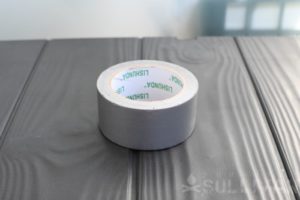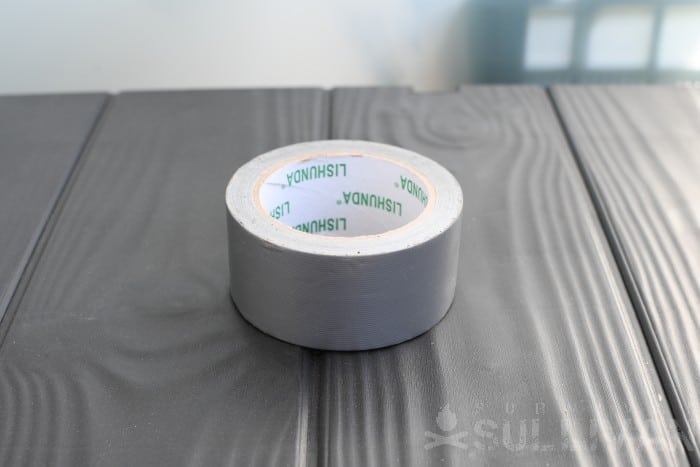Duct tape is one of those marvelous all-purpose tools that all preppers love. It has seemingly endless uses, from the mundane to the creative, and everyone you talk to will have one or more “duct tape stories” where the miracle adhesive tape saved the day, or their project. But there is one set of circumstances you almost never hear duct tape being used in- high temperatures.
So does duct tape melt? Yes, duct tape can melt thanks to the preponderance of rubber components in its backing and adhesive. At temperatures around 140 °F / 60 °C the adhesive will begin to degrade, weakening bonds and shortening its useful life. Anytime temperatures climb over 180 °F / 82 °C rubber components in both adhesive and backing may begin to melt, resulting in a total failure of the bond and disintegration of the fabric backing.
That being said, there is more to understand about the composition of duct tape that results in this temperature sensitivity. Definitely information you will want to know if you are a duct tape power user!
Duct Tape Manufacture
There are many varieties of duct tape on the market today sold by several makers with more than a few intended for specialized applications.
Despite this panoply of duct tapes to choose from, the vast majority of duct tapes consist of two major component groups: a fabric backing and a coating of pressure sensitive adhesive.
Both of these elements contain rubber or rubber derivatives, and are highly vulnerable to melting, though certain specialized varieties of duct tape have significantly higher heat resistance.
The backing material is almost always a fabric mesh, or scrim, typically made from polyester, cotton, rayon or nylon. Invariably, this backing is extremely strong and part of the reason why duct tape has such a well-earned reputation for strength.
Contrary to popular belief, duct tape does not contain any thin metal or foil core; this urban legend started because aluminum powder is typically mixed into the low-density polyethylene that coats the fabric scrim, yielding both duct tape’s impressive weather resistance and its infamous, default gray color.
The adhesive component of duct tape is invariably a pressure sensitive adhesive, abbreviated PSA.
PSAs are polymeric adhesives that are equally water-resistant, semi-solid, and able to function independently of any solvent component evaporation. This means that they are less messy than conventional glues, and bond instantly using only pressure during application.
The science behind duct tape’s adhesive is actually quite fascinating and worthy of an article all on its own, but that is for another time!
But despite its interesting manufacturing process, it cannot be the solution in all applications, and duct tape is the wrong choice for high heat applications. However, technically you might classify duct tape as non-flammable.
Duct tape will melt before it burns? How can this be?
Technicalities
The rubber adhesive used in duct tape is non-flammable, as it is the polyethylene coating surrounding the fabric scrim backing. This means that duct tape will not typically ignite when exposed to open flame.
However, such intense temperatures will produce tape failure very rapidly, and prolonged exposure to extreme heat sources and melt the rubber adhesive and the polyethylene backing to expose the fabric core which will then burn.
For this reason you should never use duct tape for any high heat application to say nothing of, worse, open flame. Even if the tape you apply does not itself burn it will warp, crinkle, shrink and fail in very short order.
Remind yourself that duct tape, at least common duct tape, is not approved for use on everyday residential HVAC ducts for that very reason; even the heat produced by a common household furnace is enough to promote failure in the silver stuff.
So while duct tape might be rated as a generally non-flammable product that in no way qualifies it for use in high heat conditions previously discussed. Relentless, thorough laboratory testing has borne this out time and time again.
Avoid these Applications
Using what we have learned you should generally avoid using duct tape for any application where the material it is applied to will itself be heated to the tape’s failure temperature, used in an environment where the ambient temperature is similarly high, or could be placed in circumstances where temperatures might unpredictably rise to that threshold.
Though duct tape’s legacy of hasty automotive repairs is legendary, having been used for everything from fender repair to holding on a broken bumper, it should never be affixed to exhaust components or any critical application in the engine compartment or on the firewall of the vehicle.
You can be assured that temperatures will exceed duct tape’s failure point in any of those locations in short order.
Also beware any item or project utilizing duct tape that will be left inside the unoccupied cabin of the car, especially when exposed to direct sunlight or in a hot climate.
Interior cabin temperatures skyrocket in such circumstances and though it might not reach the critical failure threshold it will definitely weaken the tape and its bond by a substantial degree.
Duct tape is also used for hasty modification of all kinds of tools and other gadgets, and popularly used to attach a flashlight to a long gun that lacks a mounting point otherwise.
But beware that rapid or sustained firing can easily produce temperatures at the barrel or handguard that will weaken your tape.
Alternative “Duct” Tapes for High Heat Application
Don’t despair if this revelation has dashed your hopes of using duct tape. If you, like all of us, love duct tape and want to use it for everything all the time but really need that high heat capability you are in luck. There are special varieties of duct tape on the market that are ideal for these thermally intensive applications.
Utilizing alternate adhesives that will not give up their grip when the going gets warm and a fiberglass scrim backing you can be assured of that awesome duct tape functionality no matter what you have planned.
Also consider that for certain specialized uses, any duct tape is the wrong tool for the job, period, and you should consider a metallic or foil tape or a specialty adhesive for the task.
Conclusion
Unfortunately duct tape is not the proper solution for any high temperature repair or project. Duct tape will begin to lose its strength and its grip at temperatures approaching 140° Fahrenheit (60 °C), and its components will begin to melt causing a total failure near 180° Fahrenheit (82 °C).
Don’t risk any critical repair that could be exposed to these high temperatures by utilizing duct tape.
The post So, Can Duct Tape Melt? At What Temperature? first appeared on http://taterjunction.com/.



